The Economics and Statistics Division maintains archives of previous publications for accountability purposes, but makes no updates to keep these documents current with the latest data revisions from Statistics Canada. As a result, information in older documents may not be accurate. Please exercise caution when referring to older documents. For the latest information and historical data, please contact the individual listed to the right.
<--- Return to Archive
For additional information relating to this article, please contact:
June 25, 2019CANADIAN COMMUNITY HEALTH SURVEY, 2018 Statistics Canada has released results from the 2018 Canadian Community Health Survey. This survey is an annual population health survey that provides insight into the health conditions and behaviours of the Canadian population.
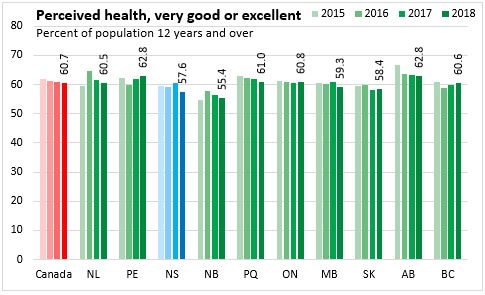
In 2018, 57.6 per cent of Nova Scotians aged 12 and over perceived their health as very good or excellent. This was just below the Canadian average of 60.7 per cent and lower than in recent years. Alberta and Prince Edward Island reported the highest proportion of the population with self-perceived very good or excellent health (62.8 per cent) and New Brunswick had the lowest (55.4 per cent).
In the same year, 15.6 per cent of Nova Scotians aged 12 and over perceived their health as fair or poor. This was higher than in recent years and the highest among the provinces in 2018. Nationally, 11.1 per cent of the population reported fair or poor health, with Quebec reporting the lowest incidence of self-perceived fair or poor health (9.7 per cent).
Perceptions of health tend to be higher for those with higher levels of household income and education, while they tend to be lower for those with lower levels in income and education.
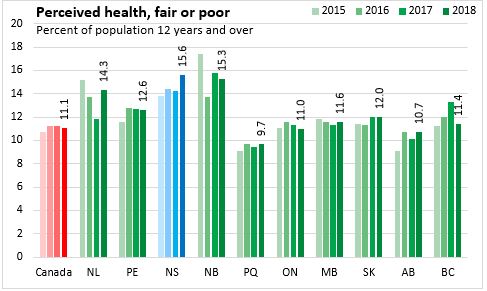
In 2018, 66.0 per cent of Nova Scotians aged 12 and over perceived their mental health as very good or excellent. This was equal to the 2017 result and remained below the Canadian average of 68.6 per cent. Quebec had the highest proportion of the population with mental health perceived as very good or excellent at 71.4 per cent.
Across the country, the share of the population reporting very good or excellent mental health has declined in recent years. Nova Scotia had the highest percentage of the population with self-perceived fair or poor mental health at 10.3 per cent of the population, above the Canadian average of 7.7 per cent. Self-perceived fair or poor mental health was lowest in Quebec (5.7 per cent of the population).
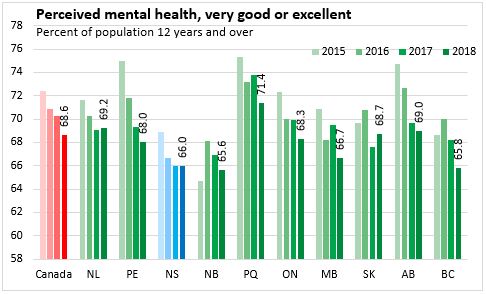
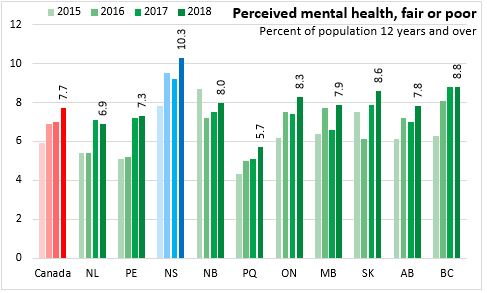
In Nova Scotia, overall perceptions of health are relatively low in part due to the province's age structure. Younger populations tend to report better health than older ones, as older cohorts are more likely to report conditions such as arthritis, diabetes, high blood pressure, and chronic obstructive pulmonary disease (COPD). Nova Scotia has a higher proportion of people over 50 years old and a smaller proportion of the population aged 12 to 49 compared to the national average. This contributes to the overall perception of health in Nova Scotia being lower in percentage terms than the national average.
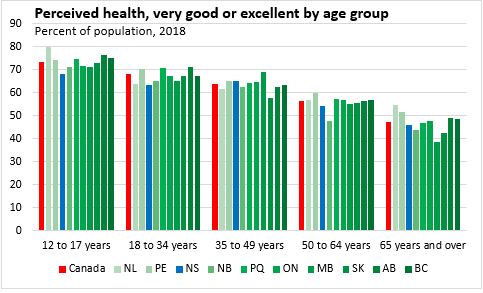
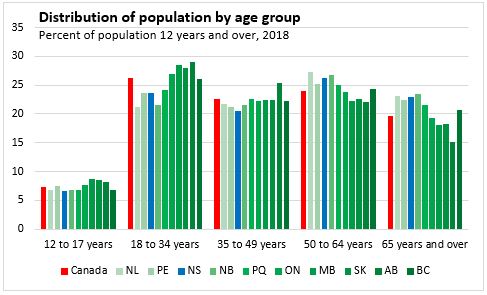
Perceived mental health as "very good or excellent" is lower for every age group in Nova Scotia compared to the national average, except those aged 50 to 64 who reported better outcomes than the national average. In 2018, the gap was largest for those aged 65 years and over.
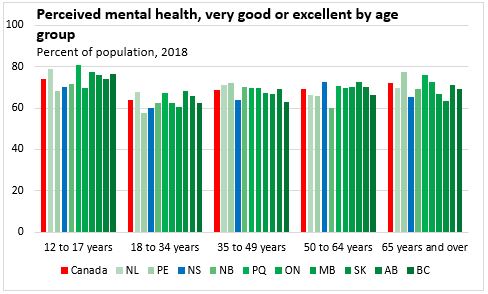
In 2018, 90.9 per cent of Nova Scotians aged 12 and over were satisfied or very satisfied with their lives. This was below the Canadian average of 93.4 per cent and the lowest among the ten provinces. The highest was in Quebec, where 94.3 per cent of the population reported being satisfied or very satisfied with life. In 2018, life satisfaction rates rose in all provinces except Nova Scotia and Manitoba.
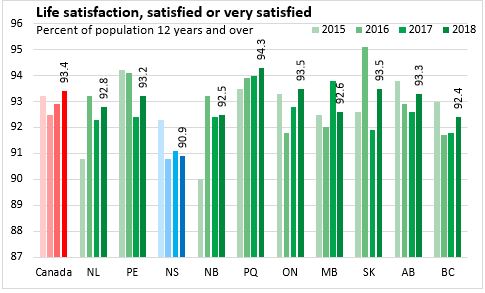
Perceived life stress measures the percentage of the population aged 12 and over who reported perceiving that most days in their life were quite a bit or extremely stressful. In 2018, 17.2 per cent of the population aged 12 and over in Nova Scotia reported perceived life stress. This was lower than in recent years and below the Canadian average of 21.0 per cent. Perceived life stress is highest among those aged 35 to 49, as well as higher among females in Nova Scotia. The lowest incidence of perceived life stress was in Newfoundland and Labrador (14.9 per cent) and the highest was in Quebec (22.7 per cent).
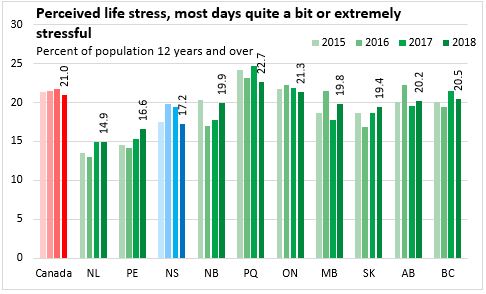
In Nova Scotia, the percent of the population aged 12 and over who reported being a daily smoker of cigarettes was 13.7 per cent in 2018. This is lower than in previous years but still higher than the Canadian average of 10.9 per cent. Daily smoking is more common among males than females, and most prevalent among those aged 35 to 64. It is also more common among those with lower levels of household income and education. The highest incidence of daily cigarette smokers in 2018 was in Saskatchewan (14.4 per cent) and the lowest was in British Columbia (7.3 per cent).
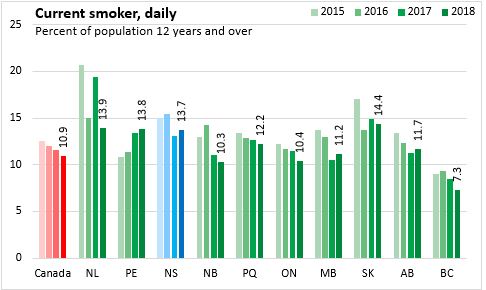
In 2018 in Nova Scotia, 46.5 per cent of the population aged 12 and over received an influenza vaccination in the past twelve months. This was the highest among the provinces, while vaccination rates in Quebec were the lowest. Nationally, 31.5 per cent of the population received an influenza vaccination in the past twelve months. In Nova Scotia, incidence of influenza vaccination was higher than the national average for every age group, and was most prevalent among those with less than high-school education.
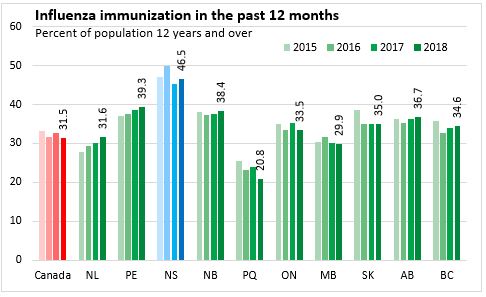
Body mass index (BMI) is based on the height and weight provided by survey respondents. It a way to classify weight according to health risk. According to World Health Organization Classification, 'overweight' BMI is 25.00 to 29.99 and 'obese' BMI is 30.00 or higher for the population aged 18 years and over. Overweight BMI is associated with an increased health risk, and obese carries high health risks.
In 2018, the percent of the population aged 18 and over who reported being overweight and obese in Nova Scotia was 36.8 per cent and 33.7 per cent, respectively. The highest incidence of overweight BMI was in New Brunswick (38.1 per cent), and the lowest was in Saskatchewan (33.3 per cent). The highest incidence of obese BMI was in Newfoundland and Labrador (40.2 per cent) and the lowest was in British Columbia (23.1 per cent). Nationally, the percentage of the population aged 18 and over who reported overweight BMI was 36.3 per cent, while 26.8 per cent reporting obese BMI.
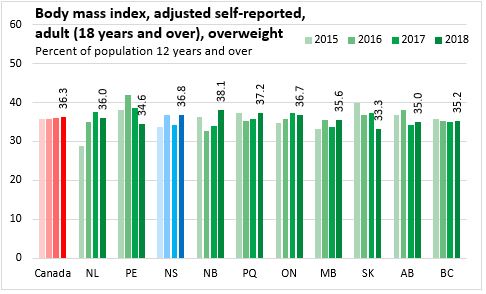
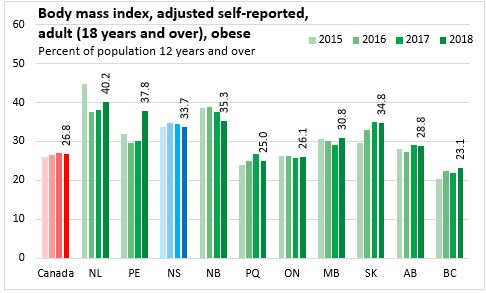
For youth aged 12 to 17, 24.8 per cent reported either overweight or obese BMI in Nova Scotia in 2018. This was above the Canadian average of 23.7 per cent. Overweight or obese BMI for youth declined in 2018 in Nova Scotia. The lowest percentage was in Prince Edward Island (18.4 per cent) and the highest was in Saskatchewan (33.4 per cent).
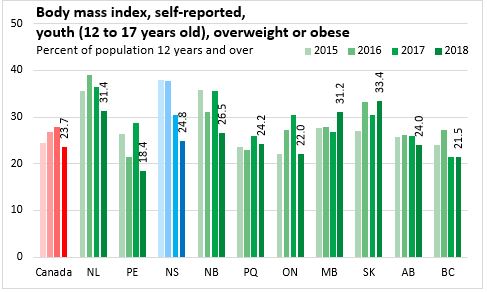
Source: Statistics Canada
Table 13-10-0096-01 Health characteristics, annual estimates
Table 13-10-0097-01 Health characteristics, annual estimates, by household income quintile and highest level of education
<--- Return to Archive